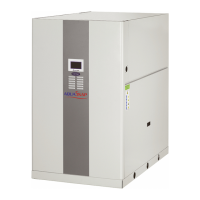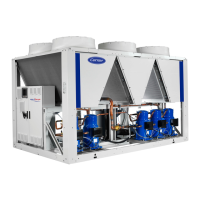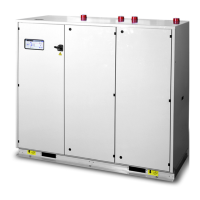44
7 - 30WGA UNIT CONNECTIONS
7.1 - Recommendations for the installation of
liquid chillers with remote condenser
The 30WGA units (split units for connection to air-cooled
condensers) have been specially designed to optimise the
operation of split system installations, using air-cooled condensers
as the chiller heat rejection system.
The refrigerant circuit installation of an operational system is limited
to the connection of the air-cooled condenser inlet and outlet to
the 30WGA unit.
The components such as the check valve (in the discharge line),
moisture sight glass and solenoid valves are installed and wired
in the factory.
The lter-drier is supplied with the unit and must be installed
upstream of the solenoid valve on the liquid line.
The TouchPilot Junior control system of the 30WGA units
incorporates the logic to permit control of the different fan versions
(xed or variable-speed).
To guarantee optimum and reliable performance of the units it is
necessary to comply with the regulations described below, when
these units are connected to remote condensers:
- Size the discharge and liquid line piping according to the
recommendations in the following paragraphs (if necessary,
install a double riser to ensure correct oil circulation in the
refrigerant circuit).
- Select a condenser with an integrated subcooler to obtain a
minimum of 3 K subcooling at the inlet to the expansion
device.
- Install the lter drier supplied with the unit as close as possible
to the liquid line lter drier.
- Install the outside air temperature sensor supplied near the
air-cooled condenser
- For units with remote condenser control (option 154), the
sensor is supplied. The outside air temperature information
is required for correct operation of the complete system.
Control of the remote air-cooled condenser using option 154
- Connect the fan stages electrically to the control board, using
auxiliary electronic board AUX 1. To assign the fan stages
refer to chapters 14 and 15 with the description of the
analogue and digital inputs and outputs.
- Make the communication bus connection (twisted and
shielded cable type for communication bus RS485) between
the specic electronic AUX 1 board, that must be integrated
in the condenser control box and the unit control board.
- The Touch Pilot Junior control is used to congure the number
of fan stages and the fan type based on the air-cooled
condenser model used in the installation.
- A fan speed controller may is recommended for the rst fan
stage for operation at low ambient temperature at part load
and for condensers with few fans.
ATTENTION: The air-cooled condenser must always be used
with a subcooler. Normally 8 K subcooling at the condenser
outlet is recommended.
7.2 - Piping installation and connection
On all units release the holding charge pressure before opening
the circuit.
Use the various valves and/or remove the safety cap from the
conical Schrader valve supplied. Push in the valve tip to release
the complete system holding charge (nitrogen).
Preparation before unsoldering the liquid and discharge line plugs:
- Remove all components that may be damaged during the
unsoldering procedure
- Pipe soldering: remove the cores from the conical Schrader
valves near the area, remove the pipe collars, remove the
cladding panels and the metal crossbars.
All these components must be replaced before commissioning
the system.
- Unsolder the plugs and prepare the pipes for connection.
- Connect the liquid line to the system, install the lter drier
upstream of the unit.
- Make the high-pressure connections (discharge line) between
the unit and the condenser.
- During these operations circulate and inert gas such as
nitrogen in the pipes to prevent the formation of copper oxyde.
IMPORTANT: The condenser circuit piping must be in
accordance with good practices relating to the static support
andthethermalexpansionofcopperpipes.
To ensure system vibration control, the collar positions on
the piping in the unit must not be changed. At the outlet of
the refrigerant section there are pipe ange collars. It is
imperative to tighten these collars to prevent vibrations and
possible breaks.

